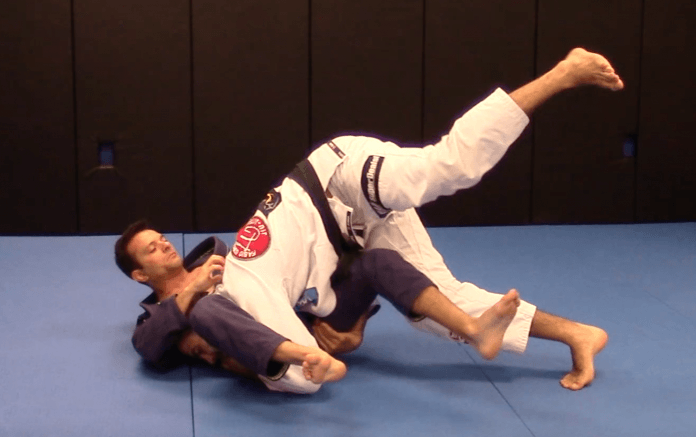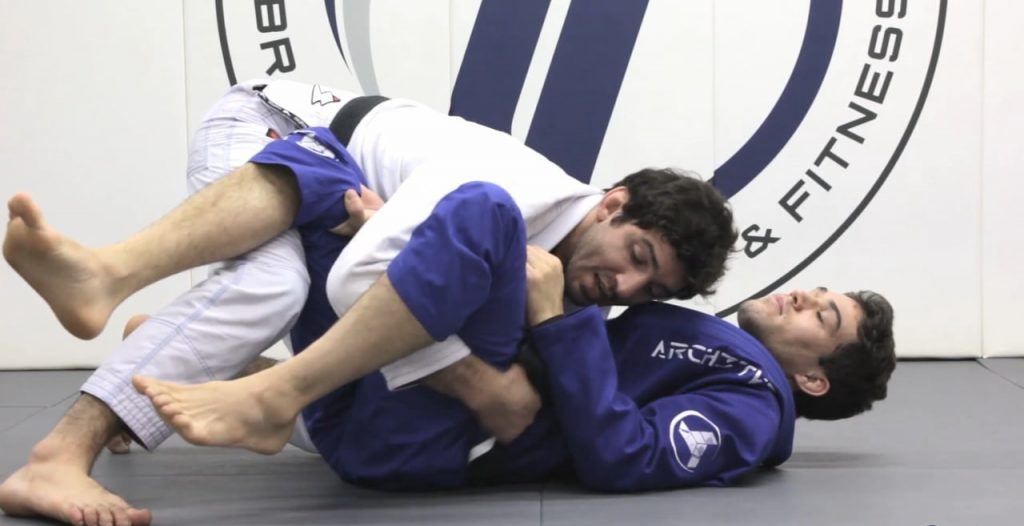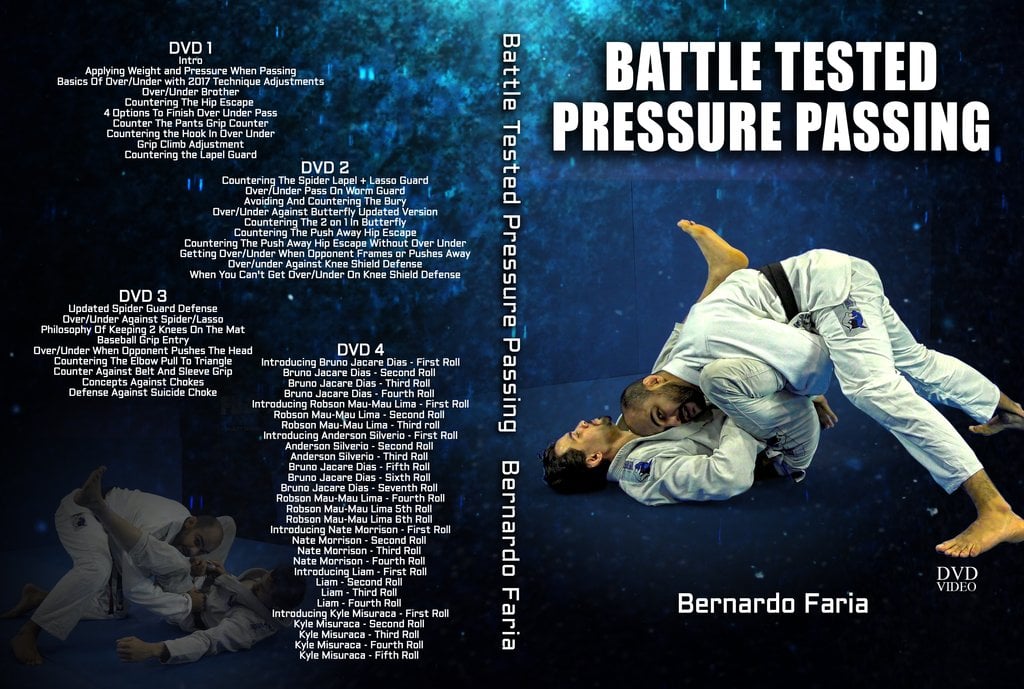
Pressure passing revolutionized the game of passing the BJJ guard. In the modern Jiu-Jitsu game, putting your opponent under as much pressure as possible is becoming mandatory. It is difficult to imagine a high-level competitive event without a great example of the efficacy of pressure passing. As this type of passing develops, different positions become more and more prominent. With all the BJJ techniques at our disposal, it is no wonder that only the best is going to work against the best. And for pressure passes, it hardly gets better than the over-under pass.
Originally, the over-under pass is a product of the Gracie Barra competitor Renato Miragaia. In modern Jiu-Jitsu, the owner of the best over-under pass technique is, of course, Bernardo Faria. The over-under pass works on the principle of complete immobilization of the opponent on the bottom. In true pressure passing style, the goal of this pass is to firmly isolate both legs, while keeping them apart at the same time. Furthermore, the success of the over-under pass is due to the fact that your whole body is exerting pressure on the opponent. Add to that the hip control and you have the perfect passing scenario. However you look at it, the over-under pass is the perfect tool. It is safe, it works at the highest levels and it fits both Gi and No-Gi.
The Pressure Of The Over-Under Pass
The over-under pass in BJJ is a virtually unstoppable guard pass. It’s predecessors, the double and single-under passes are no longer as effective as before. It is completely understandable, as most people today know a bunch of different defenses and one is bound to work. That’s where the over-under pass comes in. It is the perfect pass to do against most guards and even the most flexible guard players. The reason behind this lies in the guard’s mechanics.
The basic notion behind the over-under pass is to control both legs of the opponent while keeping them apart. This is a very powerful configuration that easily renders the opponent’s hips powerless. The basic over under position means that you are free to move your hips. One of your arms is wrapped around one leg from an ‘under’ position. The other goes over the opposite thigh, preferably reaching for the foot. This creates a bend in the leg that makes it useless. From there, the best direction to do so is up. This motion is what turns the over-under pass into a pressure pass.
What happens is that your shoulder goes directly into the opponent’s belly, causing enormous discomfort. Controlling both legs means their hips can’t move and there’s not much that they can do defensively. The pressure makes the position even worse while you’re safe and not wasting energy. Feel free to stay in this position for a while, tiring out your opponent before you eventually pass. For the pass, push to ‘over’ leg towards the middle, circling your way to side control.
-
Passing in the Gi
When passing the guard in the Gi, all the available handles make it a perfect environment for pressure passing. Even before you begin, you can control the opponent’s hips on the ‘over’ side via their lapel. Furthermore, you can use the whole length of the pants in order to establish strong rip control. For the over-under, the Gi provides a great anchoring point for the ‘under’ arm. Even if you decide not to grip the pants, (why, though?) you’ll still have a great surface to hold on to. Just remember to keep your elbows in.
For the ‘over’ leg, the Gi makes a world of difference. The ability to grip the pants means you don’t have to go for the foot. This is perfect for larger or stronger opponents. Instead, just grip somewhere along the shin-bone section of the pants. The lower the better. Finishing the pass is the same as before.
The over-under pass puts a tremendous amount of weight onto your opponent. Even if they manage to block you, it’s just temporary. Just stay there, tire their legs out a little more, and try again. Eventually, you’ll manage to pass the guard.
-
Over/under passing in No-Gi
Performing the over-under pass in No-Gi is a bit more challenging. The lack of grips and increasingly slippery surfaces provide a terrible environment for control. There are a few pointers, however, that’ll help you achieve your passing goal.
First of all, remember to go as deep as possible with the ‘under’ arm. That way, the grip is going to end up almost a full way around. Also, make sure that your shoulder is right under their knee. This is going to enable you to create leg-splitting pressure once you move in for the kill. Moreover, pressuring the opponent with your free shoulder is even more important in No-Gi. This is the main pivot point for the pass so you’ll need to be as heavy as possible. To achieve this, push off with your feet once your hips are in the air. Make sure to always stay on the balls of your feet, in order to provide increased tension on their abdomen.
In regard to the “over’ leg, trapping the foot plays is crucial. You can’t really control the leg unless you have their foot close to their butt. The best way to do it is to look for the toes. The lower you are on the foot, the better your control. Remember to keep the pressure on and not release the foot until the last moment. When you decide to circle around for the pass, use the ‘over’ arm to push the leg towards the middle, opening up the necessary space. Stay heavy on the abdomen all the way through to side control.
-
Correcting Common Mistakes
The over-under pass takes time to learn. Mastering it the way Faria has, takes decades. So, to make sure you maximize your efficiency with the pass, you have to be aware of the most common mistakes.
One thing that tends to happen over and over again is the safety of the passer. Two major questions usually arise on this front. The first is dealing with a possible Kimura attempt on your ‘over’ arm. This one is easy. Remember the foot grab tip from before? Well, as long as you’re holding their foot/pants with a tight grip, and your elbow in, there’s no Kimura. Trying to do one, your opponent is only going to make it easier to pass. Furthermore, if you distribute your weight correctly they won’t even be able to think about attacking.
Secondly, many people end up giving up on the over-under pass because their opponents post on their head or body, preventing the pass. The trouble with the head is that you have it up. If your shoulder is on their belly in a correct position, then your head won’t be able to come up. That means any attempt to redirect you is going to be futile. Even more so, attempting a post on your body is not the smartest move anyway. When they have their arm out on your body, stopping the pass is impossible because of the pressure and your positioning. Just remember, the over-under pass is a pressure pass, meaning you need to take things slowly and patiently.
Related:
One More Pressure Passing Option Perfect For Any Situation


![Darce Choke Encyclopedia – Origins, Mechanics and Variations [2025] BJJ, choke, Brabo, BJJ Darce Choke, D'arce Choke, Darce BJJ Choke](https://bjj-world.com/wp-content/uploads/2017/11/JungPoirierLeeYahoo-218x150.jpg)













![Slicin’ Calves Mikey Musumeci DVD Review [2025] Slicin' Calves Mikey Musumeci DVD Review](https://bjj-world.com/wp-content/uploads/2025/04/slicin-calves-mikey-musumeci-dvd-review-218x150.png)
![Jiu-Jitsu For Old Guys Guard Retention Bernardo Faria DVD Review [2025] Jiu-Jitsu For Old Guys Guard Retention Bernardo Faria DVD Review](https://bjj-world.com/wp-content/uploads/2025/03/old-guys-guard-retention-bernardo-faria-dvd-review-218x150.png)
![X-Guard Trickery Kyle Sleeman DVD Review [2025] X-Guard Trickery Kyle Sleeman DVD Review](https://bjj-world.com/wp-content/uploads/2025/03/x-guard-trickery-kyle-sleeman-dvd-review-218x150.png)
![Countering with Crab Ride Anthony Budion DVD Review [2025] Countering with Crab Ride Anthony Budion DVD Review](https://bjj-world.com/wp-content/uploads/2025/03/countering-with-crab-ride-anthony-budion-dvd-review-218x150.png)
![Closet Closed Guard Craig Jones DVD Review [2025] Closet Closed Guard Craig Jones DVD Review](https://bjj-world.com/wp-content/uploads/2025/03/closet-closed-guard-craig-jones-dvd-review-218x150.png)
![Xanadu Back Takes Levi Jones-Leary DVD Review [2025] Xanadu Back Takes Levi Jones-Leary DVD Review](https://bjj-world.com/wp-content/uploads/2025/03/xanadu-back-takes-levi-jones-leary-dvd-review-218x150.png)


![Upper Body Chain Attacks Janine Mocaiber DVD Review [2025] Upper Body Chain Attacks Janine Mocaiber DVD Review](https://bjj-world.com/wp-content/uploads/2025/03/upper-body-chain-attacks-janine-mocaiber-dvd-review-100x70.png)


![Modern Split Squat Passing Jason Rau DVD Review [2024] Modern Split Squat Passing Jason Rau DVD Review](https://bjj-world.com/wp-content/uploads/2024/11/modern-split-squat-passing-jason-rau-dvd-review-100x70.png)
![360 Degrees Guard Retention Thiago Abud DVD Review [2024] 360 Degrees Guard Retention Thiago Abud DVD Review](https://bjj-world.com/wp-content/uploads/2024/10/360-degrees-guard-retention-thiago-abud-dvd-review-100x70.png)




![Slicin’ Calves Mikey Musumeci DVD Review [2025] Slicin' Calves Mikey Musumeci DVD Review](https://bjj-world.com/wp-content/uploads/2025/04/slicin-calves-mikey-musumeci-dvd-review-100x70.png)
![Simplify the System Side Scissor Brian Glick DVD Review [2024] Simplify the System Side Scissor Brian Glick DVD Review](https://bjj-world.com/wp-content/uploads/2024/09/side-scissor-brian-glick-dvd-review-2024-100x70.png)
![Ginastica Natural Alvaro Romano DVD Review [2024] Ginastica Natural Alvaro Romano DVD Review](https://bjj-world.com/wp-content/uploads/2024/12/ginastica-natural-alvaro-romano-dvd-review-100x70.png)





![Efficiently Executing X-Guard Giancarlo Bodoni DVD Review [2024] Efficiently Executing X-Guard Giancarlo Bodoni DVD Review](https://bjj-world.com/wp-content/uploads/2024/09/efficiently-executing-x-guard-giancarlo-bodoni-dvd-REVIEW-100x70.png)



![Finish on the Back Ethan Crelinsten DVD Review [2024] Finish on the Back Ethan Crelinsten DVD Review](https://bjj-world.com/wp-content/uploads/2024/10/finish-on-the-back-ethan-crelinsten-dvd-review-100x70.png)


![The Empty Half Guard Michael Currier DVD Review [2025] The Empty Half Guard Michael Currier DVD Review](https://bjj-world.com/wp-content/uploads/2025/03/empty-half-guard-michael-currier-dvd-review-100x70.png)

